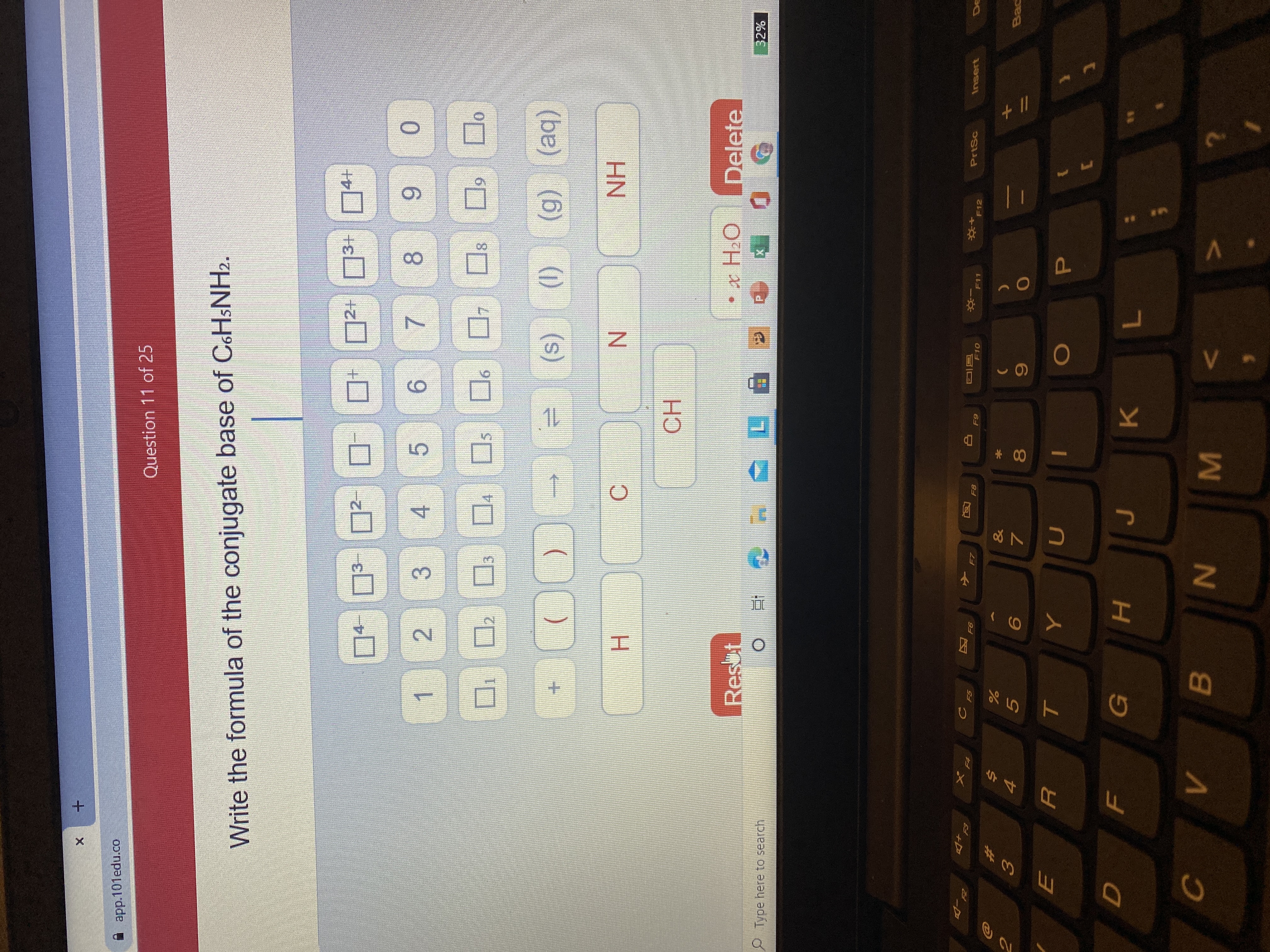
Chemistry
10th Edition
ISBN: 9781305957404
Author: Steven S. Zumdahl, Susan A. Zumdahl, Donald J. DeCoste
Publisher: Cengage Learning
expand_more
expand_more
format_list_bulleted
Concept explainers
Question
thumb_up100%

Transcribed Image Text:Write the formula of the conjugate base of C6HSNH2.
Expert Solution
This question has been solved!
Explore an expertly crafted, step-by-step solution for a thorough understanding of key concepts.
Step by stepSolved in 2 steps

Knowledge Booster
Learn more about
Need a deep-dive on the concept behind this application? Look no further. Learn more about this topic, chemistry and related others by exploring similar questions and additional content below.Similar questions
- Calculate the hydronium ion concentration in an aqueous solution of 0.293 M carbonic acid, H2CO3 (aq).[H3O+] = M.arrow_forwardBased on the Lewis structures of the reactants and product of the following equation, identify the Lewis acid and the Lewis base in it: CO, + OH → HCO, =c=0: + :0-H H-0- O: O Lewis acid: CO,; Lewis base: HCO, O Lewis acid: OH; Lewis base: CO, O Lewis acid: CO; Lewis base: OH-arrow_forwardWhat is the pH of .242 M H2CO3 (aq)? O 6.38 O 3.50 O 10.50 O 4.12 O 5.47arrow_forward
- Calculate the pH of a solution by dissolving 1.90 g of sodium acetate, CH3COONa, in 71.0 mL of 0.15 M acetic acid, CH3COOH(aq). Assume the volume change upon dissolving the sodium acetate is negligible. Last of CH3COOH is 1.75 x 10^-5arrow_forwardComplete the balanced chemical reaction for the following weak base with a strong acid. In this case, write the resulting acid and base as its own species in the reaction. NH3(aq) + HCl(aq) – ->arrow_forwardThe acid dissociation constant K of hydrocyanic acid (HCN) is 6.2 × 10¯¹⁰. Calculate the pH of a 6.9M solution of hydrocyanic acid. Round your answer to 1 decimal place.arrow_forward
- Suppose a 0.25 M aqueous solution of phosphoric acid (H3PO4) is prepared. Calculate the equilibrium molarity of HPO4 2−. You'll find information on the properties of phosphoric acid in the ALEKS Data resource. Round your answer to 2 significant digits.arrow_forwardComplete the balanced chemical equation for the following reaction between a weak acid and a strong base CH3NH3Cl(aq) + NaOH(aq) ->arrow_forwardThe value pKw is 11.05 at 78 °C. What is the pH of a neutral solution at the same temperature? Enter your answer with two decimal places.arrow_forward
- The chemical formulae of some acids are listed in the first column of the table below, and in the second column it says whether each acid is strong or weak. Complete the table. List the chemical formula of each species present at concentrations greater than about 106 mo mo-when about a tenth of a mole of the acid is L dissolved in a liter of water. The chemical formulae of some acids are listed in the first column of the table below, and in the second column it says whether each acid is strong or weak. Complete the table. List the chemical formula of each species present at concentrations greater than about 10-6 mol/L when about a tenth of a mole of the acid is dissolved in a liter of water. acid strong or weak? species present at 10-6 mol/L or greater when dissolved in water ICIO weak H₂SO, weak IICI strong HCIO, strong ☐ x DO....arrow_forwardWhat is the conjugate acid for H_2SO_3(aq)?arrow_forwardpH = −log[H+] where [H+] is the hydrogen ion concentration, measured in moles per liter. Solutions with a pH-value of less than 7 are acidic; solutions with a pH-value of greater than 7 are basic; solutions with a pH-value of 7 (such as pure water) are neutral. Black coffee has a pH of 5 and pure water has a pH of 7. Compare the pH of each and determine how much more acidic black coffee is than pure water.arrow_forward
arrow_back_ios
SEE MORE QUESTIONS
arrow_forward_ios
Recommended textbooks for you
 ChemistryChemistryISBN:9781305957404Author:Steven S. Zumdahl, Susan A. Zumdahl, Donald J. DeCostePublisher:Cengage Learning
ChemistryChemistryISBN:9781305957404Author:Steven S. Zumdahl, Susan A. Zumdahl, Donald J. DeCostePublisher:Cengage Learning ChemistryChemistryISBN:9781259911156Author:Raymond Chang Dr., Jason Overby ProfessorPublisher:McGraw-Hill Education
ChemistryChemistryISBN:9781259911156Author:Raymond Chang Dr., Jason Overby ProfessorPublisher:McGraw-Hill Education Principles of Instrumental AnalysisChemistryISBN:9781305577213Author:Douglas A. Skoog, F. James Holler, Stanley R. CrouchPublisher:Cengage Learning
Principles of Instrumental AnalysisChemistryISBN:9781305577213Author:Douglas A. Skoog, F. James Holler, Stanley R. CrouchPublisher:Cengage Learning Organic ChemistryChemistryISBN:9780078021558Author:Janice Gorzynski Smith Dr.Publisher:McGraw-Hill Education
Organic ChemistryChemistryISBN:9780078021558Author:Janice Gorzynski Smith Dr.Publisher:McGraw-Hill Education Chemistry: Principles and ReactionsChemistryISBN:9781305079373Author:William L. Masterton, Cecile N. HurleyPublisher:Cengage Learning
Chemistry: Principles and ReactionsChemistryISBN:9781305079373Author:William L. Masterton, Cecile N. HurleyPublisher:Cengage Learning Elementary Principles of Chemical Processes, Bind...ChemistryISBN:9781118431221Author:Richard M. Felder, Ronald W. Rousseau, Lisa G. BullardPublisher:WILEY
Elementary Principles of Chemical Processes, Bind...ChemistryISBN:9781118431221Author:Richard M. Felder, Ronald W. Rousseau, Lisa G. BullardPublisher:WILEY

Chemistry
Chemistry
ISBN:9781305957404
Author:Steven S. Zumdahl, Susan A. Zumdahl, Donald J. DeCoste
Publisher:Cengage Learning

Chemistry
Chemistry
ISBN:9781259911156
Author:Raymond Chang Dr., Jason Overby Professor
Publisher:McGraw-Hill Education

Principles of Instrumental Analysis
Chemistry
ISBN:9781305577213
Author:Douglas A. Skoog, F. James Holler, Stanley R. Crouch
Publisher:Cengage Learning

Organic Chemistry
Chemistry
ISBN:9780078021558
Author:Janice Gorzynski Smith Dr.
Publisher:McGraw-Hill Education

Chemistry: Principles and Reactions
Chemistry
ISBN:9781305079373
Author:William L. Masterton, Cecile N. Hurley
Publisher:Cengage Learning

Elementary Principles of Chemical Processes, Bind...
Chemistry
ISBN:9781118431221
Author:Richard M. Felder, Ronald W. Rousseau, Lisa G. Bullard
Publisher:WILEY